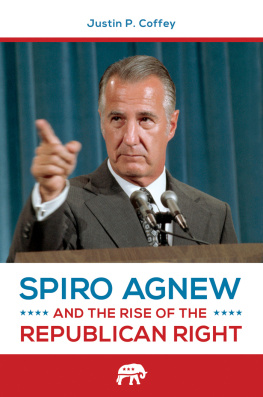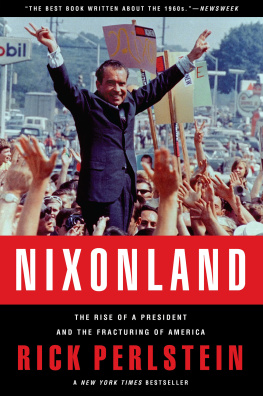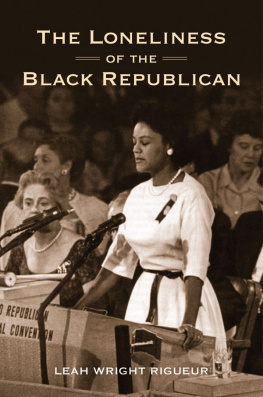Spiro Agnew and the Rise
of the Republican Right
JUSTIN P. COFFEY

Copyright 2015 by Justin P. Coffey
All rights reserved. No part of this publication may be reproduced, stored in a retrieval system, or transmitted, in any form or by any means, electronic, mechanical, photocopying, recording, or otherwise, except for the inclusion of brief quotations in a review, without prior permission in writing from the publisher.
Library of Congress Cataloging-in-Publication Data
Coffey, Justin P., author.
Spiro Agnew and the rise of the Republican right / Justin P. Coffey.
pages cm
Includes bibliographical references and index.
ISBN 9781440841415 (hard copy : alk. paper) ISBN 9781440841422 (ebook) 1. Agnew, Spiro T., 19181996. 2. Vice-PresidentsUnited StatesBiography. 3. United StatesPolitics and government19691974. I. Title.
E840.8.A34C552015
352.239092dc232015024608
[B]
ISBN: 9781440841415
EISBN: 9781440841422
19 18 17 16 15 1 2 3 4 5
This book is also available on the World Wide Web as an eBook.
Visit www.abc-clio.com for details.
Praeger
An Imprint of ABC-CLIO, LLC
ABC-CLIO, LLC
130 Cremona Drive, P.O. Box 1911
Santa Barbara, California 93116-1911
This book is printed on acid-free paper 
Manufactured in the United States of America
Contents
Introduction
In his account of his fall from power, Spiro Agnew claimed that part of his problems arose from being a conservative at a time when liberals captured the imagination and sympathy of the communications media. When Agnew began his political career he fashioned himself as a pragmatic moderate. A Baltimore County executive, Agnew eschewed ideology and charted a middle path, one that he hoped the Republican Party would adopt. In 1964, Agnew opposed Senator Barry Goldwaters candidacy for the Republican presidential nomination. When he ran for governor of Maryland in 1966, Agnew continued to portray himself as a moderate, and during much of the 1960s, Agnew denounced political extremism and was particularly critical of the right-wing of the GOP. But as Agnew climbed up the political ladder, his views evolved and his political metamorphosis helped earn him a spot on the Republican presidential ticket in 1968.
Vice President Agnew continued to move to the right, as did the Republican Party. During the 1950s and into the 1960s ideologues battled for control of the GOP. Conservatives achieved a monumental triumph in 1964 when Barry Goldwater captured the Republican nomination for president. While the conservatives had won a battle, the fight for the future of the GOP was hardly over. Goldwaters crushing defeat caused soul-searching among the partys faithful. Two years after the Goldwater debacle, Republican moderates and liberals scored a number of victories, including Agnew taking the Maryland gubernatorial election.
Agnew took part in the struggle within the Republican Party. In the mid-to late-1960s it was by no means evident that the right-wing would take control of the GOP. For decades the Republicans had struggled to find a winning political strategy. Ever since the Great Depression, the Democrats had dominated the political landscape. Franklin D. Roosevelts election in 1932 ushered in an era of Democratic control of the presidency and Congress. From 1932 through 1964 the Democrats controlled both houses of Congress for all but four years. The Republicans had won the presidency just twice, in 1952 and 1956 when Dwight Eisenhower was able to take enough votes from the Democratic coalition to win the presidency.
But in the early 1960s, the Republicans were still a minority party. Vice President Richard M. Nixon lost to Senator John F. Kennedy in the 1960 election, and afterward, the liberals, moderates, and conservatives in the party battled over the direction of the GOP. Many on the right blamed Nixons defeat on his middle-of-the-road approach, arguing that the Republicans needed, for political and ideological reasons, to move rightward. The moderates, such as Nixon and Eisenhower, wanted to stay the course, while liberals pushed for a more progressive agenda.
At the time Agnew aligned himself with both the moderates and the liberals. His journey from moderation to conservatism mirrored that of the GOP. Eventually the Right took control of the GOP. The conservative revolution not only changed the makeup and direction of the GOP, but also fundamentally realigned the electoral map.
Race played the critical role in the transformation. Beginning with Harry S. Truman in the late 1940s, many leading Democrats began calling for an end to Jim Crow laws. In 1948 Truman issued an executive order desegregating the military and publicly endorsing an end to the poll tax. Trumans aggressive support of a civil rights agenda enraged segregationists and led to a revolt at the 1948 Democratic Convention. Delegates from five states walked out and nominated South Carolina governor Strom Thurmond and Mississippis Fielding L. Wright on the Dixiecrat ticket. Thurmond and Wright took four states but their protest party ended as quickly as it appeared. As the Civil Rights Movement gained momentum during the 1950s, Southern Democrats reacted with dismay and sought to maintain segregation at all costs. Two years after the Supreme Court issued its ruling in Brown v. Board of Education in 1954, twenty senators and eighty-two representatives signed the Southern Manifesto, calling for resistance to further attempts at desegregation.
But the Southerners were fighting against their own party. The estrangement between the Southern wing and the rest of the party grew in the early 1960s as Kennedy and then Lyndon B. Johnson gradually embraced the civil rights cause. The ardent segregationists saw Johnsons signing of the 1964 Civil Rights Act as a betrayal. Goldwaters vote against the bill made himand the Republican Partyan acceptable alternative to Johnson and the Democrats. For over a century the Democrats controlled much of the South and the Republicans stood almost no chance of winning any part of Dixie in presidential contests. In 1964, however, Goldwater became the first Republican since Reconstruction to win South Carolina, Georgia, Alabama, Mississippi, and Louisiana.
The results marked the end of the solid South. Johnsons overwhelming victory overshadowed signs that the Roosevelt coalition was beginning to crack. Over the next few years the Republicans continued to make inroads in the states of the former Confederacy. By 1968 Blue Dog Democrats were deserting their party in droves. In that years election, Democrat Hubert H. Humphrey won just 22 percent of the Southern vote and just one Southern stateTexas. Between them, Richard Nixon and George Wallace carried the rest of the South, with Wallace capturing the Deep South and Nixon the rest.
A number of Nixons critics contended that Agnew was on the ticket in 1968 as part of Nixons Southern Strategy. Agnew, the theory went, would offset Wallaces appeal to white voters, particularly in the South and in border-states. To Nixon, Agnew was an attractive running mate with his forceful denunciation of civil rights activists at a meeting in Maryland in the wake of Martin Luther King Jr.s assassination in April 1968. Rioting broke out in Baltimore and Agnew blamed much of the disorder on Marylands African American leaders. Ironically, Agnews support from black voters helped make him governor of Maryland. In the 1966 gubernatorial contest, Agnew was viewed as a progressive on race, particularly when juxtaposed against his opponent. But by 1968 all the goodwill between Agnew and Marylands African American community had evaporated.
Next page









